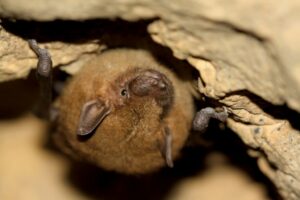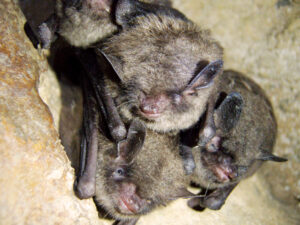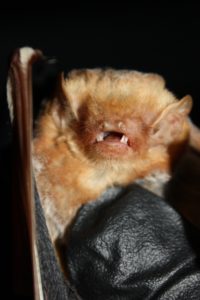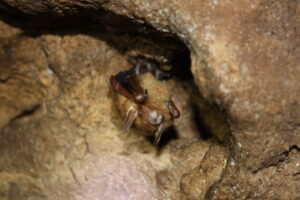By Kelly Vowels

Bats often get a bad reputation, but they’re a vital part of a healthy ecosystem. Bats can pollinate plants, others eat insects, and serve a key role as prey in the food chain. Their presence ensures the health of cave ecosystems and they are what’s known as an indicator species, meaning their presence indicates the health of an ecosystem. As a large, pristine forest, Bernheim is an ideal habitat for bats. Not only do we work to protect them, we also conduct research on the eleven species of bat found within our forest. Our discoveries help guide best practices in protecting these magnificent creatures throughout the U.S. and beyond.
Bats use reflected sound, or echolocation, to navigate and hunt. In the past decades, acoustic monitoring using ultrasonic detection equipment has become a useful tool to identify bats in a wide range of habitats. Because bats do not have to be handled or disturbed, it is less intrusive than mist-netting and winter cave surveys, and allows more areas to be surveyed.

With the spread of white-nose syndrome (WNS) in the eastern United States and the decline of many species of bats, acoustic monitoring may be the only tool for widespread bat monitoring. WNS is a disease of cave hibernating bats caused by the fungus, Pseudogymnoascus destructans, which causes frequent arousal of hibernating bats, resulting in the depletion of fat reserves. Some of the hardest hit species were once some of the most common bats encountered during mist-netting and other surveys, and now are in danger of going extinct. With the decline of many bat species, mist-netting has become ineffective because the smaller bat population makes it harder for biologists to capture them with the nets. Acoustic monitoring may be a good replacement for learning about these rare bat species.
Bernheim Forest began acoustic monitoring in 2014 with only a small survey to get a more accurate estimate of species richness. The efforts continued through 2019 when we were finally able to survey enough sites to get a good representation of Bernheim Forest. More years and areas would need to continue to be surveyed to get a more accurate picture of the bat populations at Bernheim. Still, the data collected from 2017-19 gives a good view of the locations of bat species and will help in future management of the forests. This report is only on data collected from 2019, but a forthcoming report will compile all the data.
Acoustic surveys were conducted at 93 sites at Bernheim. The sites included streams, wildlife ponds, glades, dirt roads, gravel roads, and caves. The detectors were moved to different sites more frequently from June to August since this is peak bat movement time. The detectors were left at high bat frequency sites for longer during March, April, and October through December. The recordings started one hour before sunset and continued until one hour after sunrise. The recordings ran through software that converts frequency and analyzes the data. Two software programs were used and then compared to determine agreement between them. The numbers of calls for each species were then combined to determine the commonly identified bat species for Bernheim Forest.

Research using both analyses identified 11 bat species in Bernheim Forest, big brown bat (Eptesicus fuscus), red bat (Lasiurus borealis), hoary bat (Lasiurus cinereus), silver-haired bat (Lasiurus noctivagans), evening bat (Nycticeius humeralis), tricolor bat (Pipistrellus subflavus), Rafinesque big-eared bat (Corynorhinus rafinesquii), little brown bat (Myotis lucifugus), gray bat (Myotis grisescens), southeastern bat (Myotis austroriparius, northern bat (Myotis septentrionalis), and Indiana bat (Myotis sodalist.)
Townsend’s big-eared bat (Corynorhinus townsendii) and small-footed bat (Myotis leibii) were identified by one software, but we believe that C. townsendii was probably misidentified since its echolocation is similar to C. rafinesquii, and C. rafinesquii is more likely found at Bernheim Forest than C. townsendii, but this cannot be conclusively determined since information on Corynorhinus in Kentucky is not fully known.
One monitoring tool identified 27,313 bat calls with 7,938 calls identified to species, while the other identified 7,943 bat calls with 7,573 identified to species. The greatest number of calls were recorded during July, August, and September. Bat activity may be higher in early summer and later in the summer when pregnant and lactating female bats and pups have the most energy. Fall migration may account for the peaks in September and October.

Evening bat was the most commonly identified bat. The research was mixed on the next most common, with results showing higher populations of gray bat, which is federally threatened, little brown bat, big brown bat, and silver-haired bat. The two most commonly identified Myotis species were little brown bat, gray bat, and the Indiana bat, which is federally endangered. The least encountered Myotis was small-footed bat.
Bernheim is committed to protecting these wonderful creatures and promoting greater understanding of our bat species. Our work to protect land and restore habitats is critical to bat conservation efforts. With white-nose syndrome reducing bat numbers, it is more important than ever to focus on habitat improvements and protecting land that provides forage, roosts, and maternity sites.

